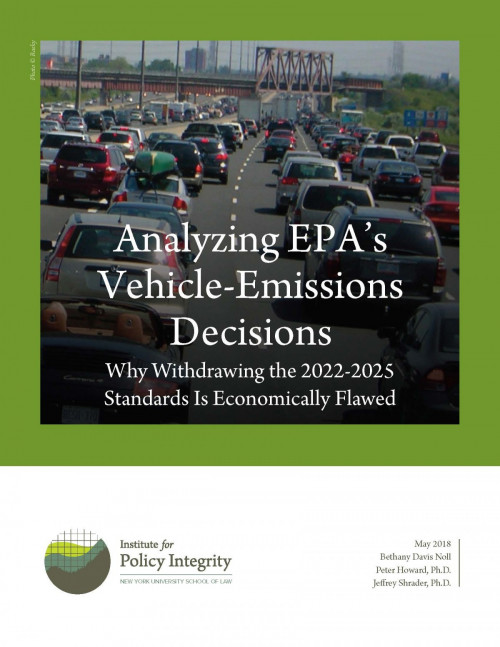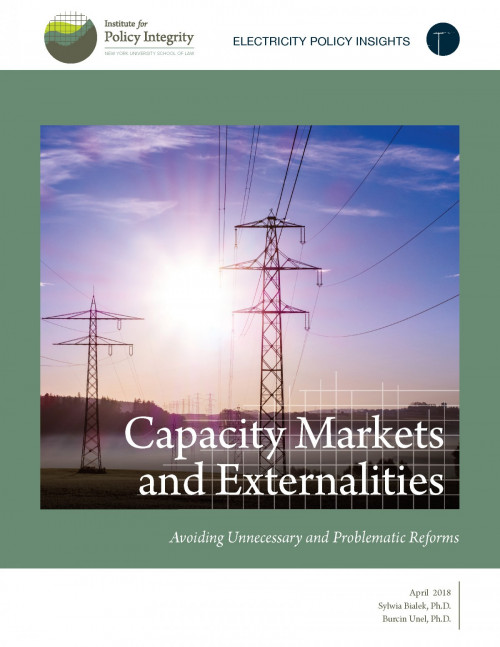-
Comments to New York on Offshore Wind Program
New York State is considering setting a procurement goal of 2,400 MWs worth of new offshore wind generation facilities by 2030. In our comments to the New York Public Service Commission, we encourage the Commission to continue the use of the Social Cost of Carbon to value the benefits of avoiding greenhouse-gas emissions in the state’s Offshore Wind Policy. We also explain that the proposal to pay for the benefits of offshore wind outside of the wholesale markets is a reasonable way to move closer to internalizing the external costs of carbon-dioxide emissions and other pollution.
-
Comments to California on Regulating Greenhouse Gas Emissions from Vehicles
EPA has indicated that it intends to weaken its emission standards for light-duty vehicles and that it may attempt to revoke California’s ability under the Clean Air Act to maintain these protective standards. Our comments to California’s Air Resources Board (CARB) discuss the substantial economic benefits that California would gain from maintaining the more stringent standards that both EPA and California currently require. We submitted our report, Analyzing EPA’s Vehicle-Emissions Decisions, to CARB to provide additional information on why weakening vehicle emission standards set for years 2022-2025 would be economically irrational.
-
Comments to New York on Electricity Rate Design
New York State is in the process of reforming its payment system for distributed energy resources (DERs), such as rooftop solar panels, away from a net energy metering policy that compensated these resources at retail electricity rates. Our comments to the New York Public Service Commission encourage the state to move towards rate designs that better reflect the underlying costs of generating, transmitting, and distributing electricity, including environmental externalities for all customers, including those who do not own DERs. Our joint comments with other stakeholders also offer high-level principles for rate design that can help achieve the state’s clean energy goals.
-
Oral Comments to EPA’s Science Advisory Board
EPA’s Science Advisory Board provides independent scientific guidance to the Agency. Our oral comments to EPA’s Science Advisory Board encourage the Board to review the science and economics behind EPA’s proposed deregulatory actions. We ask the Board to consider our recent paper on the full value of reducing particulate matter (PM) pollution in evaluating the benefits of reducing PM below the current National Ambient Air Quality Standards. Our comments also ask the Board to review EPA’s manipulation of economics in order to downplay the climate harms of its deregulatory actions. Specifically, we discuss manipulations of the 2016 Interagency Working Group’s Social Cost of Carbon estimates. We argue that EPA’s new “interim” estimate for the Social Cost of Carbon ignores the global nature of climate damage and obscures the devastating effects that climate change will have on future generations, and we strongly encourage review of the methods used to reach this new “interim” estimate.
-
Comments to BOEM on Offshore Wind Program
The Bureau of Ocean Energy Management (BOEM) is responsible for leasing offshore areas for energy development, including areas for wind energy. The agency has so far awarded 13 commercial offshore wind leases, totaling about 17 GW of capacity. In response to its request for feedback on the future of its offshore wind program for the Atlantic Outer Continental Shelf, our comments to BOEM suggest steps toward developing a robust offshore wind program that will deliver benefits to the public for decades to come.
-
Comments to FERC on Electric Grid Resilience Order
The Federal Energy Regulatory Commission (FERC) requested feedback from regional electricity regulators on the state of resilience in wholesale markets, efforts underway to ensure grid resilience, and opportunities for future improvement. Their responses make clear that while grid resilience is an issue worthy of continued attention, there is not currently evidence to support mandatory, national or even regional action to address acute resilience concerns. Our comments to FERC argue that it should not seek a “one-size-fits-all” solution for all Regional Transmission Organizations and Independent System Operators (RTOs/ISOs), nor should it consider resilience a “catch-all” concept that opens the door to otherwise unsupported or unnecessary actions.
-
Comments to FERC on PJM Capacity Market Repricing Proposal
PJM Interconnection, L.L.C (PJM), a regional electricity transmission organization serving 13 states and Washington D.C., recently submitted a proposal to the federal government requesting changes that would “mitigate” the impact of state climate and energy policies on electricity markets. In our comments to the Federal Energy Regulation Commission (FERC), we argue that PJM’s proposals rest on a faulty premise that state public policies are distorting the economic efficiency of capacity market price signals, which heavily affect how generators enter and exit the market.
-
Comments to NHTSA on Civil Penalties for Violating Fuel Economy Standards
In December 2016, pursuant to the Inflation Adjustment Act of 2015, the National Highway Traffic Safety Administration (NHTSA) finalized a rule that adjusted civil penalties for car manufacturers that violate fuel economy standards, in order to line them up better with inflation. That rule put the penalties at $14 per tenth of a mile per gallon. NHTSA is now proposing a new rule to lower the penalties from $14 per tenth of a mile per gallon back to the previous rate of $5.50 per tenth of a mile per gallon, claiming that the $14 penalty would have a significant negative economic impact. Our May 2018 comments argue that NHTSA should explain why it is justified in reducing the penalty from $14 to $5.50 and consider the forgone benefits when considering whether the civil penalties will have a “negative economic impact.” Because NHTSA has not provided this explanation, the proposed reduction is arbitrary and capricious.
-

Analyzing EPA’s Vehicle-Emissions Decisions
Why Withdrawing the 2022-2025 Standards Is Economically Flawed
The Environmental Protection Agency sets greenhouse gas emissions standards for cars and light trucks, and it periodically reevaluates these standards to make sure that car manufacturers can comply. In April 2018, EPA withdrew its previous determination that standards for model year 2022–2025 vehicles were appropriate and would improve public welfare, now saying that more recent information suggests that the standards are too stringent. Our policy brief shows that EPA’s claim—that new information indicates that the assumptions underlying the previous determination are unrealistic—is not supported by the evidence. In fact, the opposite is the case. Recent trends in fuel prices, vehicle sales, automaker compliance, and safety all indicate that the existing 2022–2025 standards can be met at low cost while delivering large benefits to consumers and the economy. EPA’s decision to withdraw the standards will instead cause regulatory uncertainty that will hurt the automotive sector while also harming the environment.
-

Capacity Markets and Externalities
Avoiding Unnecessary and Problematic Reforms
Many states are taking action on climate change by paying zero- and low-emitting electricity generators for avoiding the emissions that fossil-fuel-fired resources would otherwise emit. These “externality payments” help level the playing field between emitting and non-emitting generators. Critics of these policies argue that these payments might negatively affect the efficiency of wholesale electricity markets by reducing capacity prices, which heavily affect how generators enter and exit the market. Our report shows why the premises underlying recent reforms, which seek to shield capacity markets from the potential price impact of pollution externality payments, are flawed.
Viewing recent projects in Climate and Energy Policy




